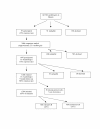Drive time to cardiac rehabilitation: at what point does it affect utilization?
- PMID: 20525345
- PMCID: PMC2900239
- DOI: 10.1186/1476-072X-9-27
Drive time to cardiac rehabilitation: at what point does it affect utilization?
Abstract
Background: A 30 minute drive time threshold has often been cited as indicative of accessible health services. Cardiac rehabilitation (CR) is a chronic disease management program designed to enhance and maintain cardiovascular health, and geographic barriers to utilization are often cited. The purpose of this study was to empirically test the drive time threshold for CR utilization.
Methods: A prospective study, using a multi-level design of coronary artery disease outpatients nested within 97 cardiologists. Participants completed a baseline sociodemographic survey, and reported CR referral, enrollment and participation in a second survey 9 months later. CR utilization was verified with CR sites. Geographic information systems were used to generate drive times at 60, 80 and 100% of the speed limit to the closest CR site from participants' homes, to take into consideration various traffic conditions. Bivariate analysis was used to test for differences in CR referral, enrollment and degree of participation by drive time. Logistic regression was used to test drive time increments where significant differences were found.
Results: Drive times were generated for 1209 outpatients. Overall, CR referral was verified for 523 (43.3%) outpatients, with verified enrollment for 444 (36.7%) participating in a mean of 86.4 +/- 25.7% of prescribed sessions. There were significant differences in CR referral and enrollment by drive time (ps < .01), but not degree of participation. Logistic regression analysis (ps < .001) revealed that the drive time threshold at 80% of the posted speed limit for physician referral may be 60 minutes (OR = .26, 95% CI: 0.13-0.55), and the threshold for patient CR enrollment may also be 60 minutes (OR = .11, 95% CI: 0.04-0.33).
Conclusions: Physicians may be taking geography into consideration when referring patients to CR. Empirical consideration also reveals that patients are significantly less likely to enroll in CR where they must drive 60 minutes or more to the closest program. Once enrolled, distance has no significant effect on degree of participation.
Figures
Similar articles
-
Cardiac rehabilitation wait times: effect on enrollment.J Cardiopulm Rehabil Prev. 2011 Nov-Dec;31(6):373-7. doi: 10.1097/HCR.0b013e318228a32f. J Cardiopulm Rehabil Prev. 2011. PMID: 21826016
-
Contribution of patient and physician factors to cardiac rehabilitation referral: a prospective multilevel study.Nat Clin Pract Cardiovasc Med. 2008 Oct;5(10):653-62. doi: 10.1038/ncpcardio1272. Epub 2008 Jun 10. Nat Clin Pract Cardiovasc Med. 2008. PMID: 18542104 Free PMC article.
-
A prospective comparison of cardiac rehabilitation enrollment following automatic vs usual referral.J Rehabil Med. 2007 Apr;39(3):239-45. doi: 10.2340/16501977-0046. J Rehabil Med. 2007. PMID: 17468793 Free PMC article. Clinical Trial.
-
Smoking and cardiac rehabilitation participation: Associations with referral, attendance and adherence.Prev Med. 2015 Nov;80:67-74. doi: 10.1016/j.ypmed.2015.04.009. Epub 2015 Apr 18. Prev Med. 2015. PMID: 25900804 Free PMC article. Review.
-
Interventions to promote patient utilisation of cardiac rehabilitation.Cochrane Database Syst Rev. 2019 Feb 1;2(2):CD007131. doi: 10.1002/14651858.CD007131.pub4. Cochrane Database Syst Rev. 2019. PMID: 30706942 Free PMC article.
Cited by
-
Do acute myocardial infarction and stroke mortality vary by distance to hospitals in Switzerland? Results from the Swiss National Cohort Study.BMJ Open. 2016 Nov 1;6(11):e013090. doi: 10.1136/bmjopen-2016-013090. BMJ Open. 2016. PMID: 27803109 Free PMC article.
-
Proximity of Water Wells to Public Water Testing Facilities in Alberta Using Drive Times.Environ Health Insights. 2022 Nov 14;16:11786302221137437. doi: 10.1177/11786302221137437. eCollection 2022. Environ Health Insights. 2022. PMID: 36408333 Free PMC article.
-
Barriers to and motives for engagement in an exercise-based cardiac rehabilitation programme in Ireland: a qualitative study.BMC Prim Care. 2022 Feb 11;23(1):28. doi: 10.1186/s12875-022-01637-7. BMC Prim Care. 2022. PMID: 35148675 Free PMC article.
-
Relationship Between Community-Level Distress and Cardiac Rehabilitation Participation, Facility Access, and Clinical Outcomes After Inpatient Coronary Revascularization.Circ Cardiovasc Qual Outcomes. 2023 Nov;16(11):e010148. doi: 10.1161/CIRCOUTCOMES.123.010148. Epub 2023 Oct 19. Circ Cardiovasc Qual Outcomes. 2023. PMID: 37855157 Free PMC article.
-
Cardiac Rehabilitation for Aboriginal and Torres Strait Islander people in Western Australia.BMC Cardiovasc Disord. 2016 Jul 13;16:150. doi: 10.1186/s12872-016-0330-3. BMC Cardiovasc Disord. 2016. PMID: 27412113 Free PMC article.
References
-
- Organization for Economic Cooperation and Development. International Mortality Data. 2001.
-
- Brown A, Taylor R, Noorani H, Stone J, Skidmore B. Exercise-based cardiac rehabilitation programs for coronary artery disease: a systematic clinical and economic review. 2003. Technology Report no. 34.
-
- Taylor RS, Brown A, Ebrahim S, Jolliffe J, Noorani H, Rees K, Skidmore B, Stone JA, Thompson DR, Oldridge N. Exercise-based rehabilitation for patients with coronary heart disease: systematic review and meta-analysis of randomized controlled trials. Am J Med. 2004;116:682–692. doi: 10.1016/j.amjmed.2004.01.009. - DOI - PubMed
Publication types
MeSH terms
Grants and funding
LinkOut - more resources
Full Text Sources



